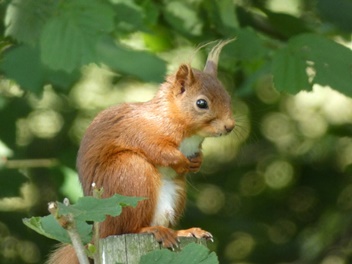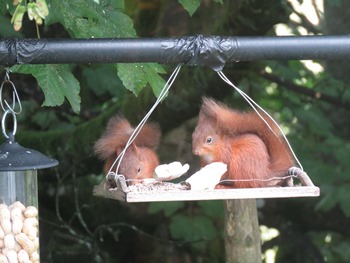The Sedbergh Red Squirrel Group

History of the Red Squirrel in Britain
Red squirrels (Sciurus Vulgaris) are native to the British Isles. They arrived here several thousand years ago, at the end of the last ice age when there was a land bridge across what we now call the English Channel. As the ice cap and tundra gave way to the mixed woodland that was to cover most of the land, the red squirrels moved west and north, exploiting the new habitats created by the advance of the forests. They have lived here ever since.
The problem is that, after over ten thousand years, there is a very real danger that red squirrels could soon become extinct in Britain. They have been all but wiped out in southern England and, even in the north and in Scotland, they are under threat.

As with many extinction scenarios, the decline of the red squirrel has a number of causes.
The arrival of farming in Britain about 7,000 years ago eventually led to a massive destruction of the natural woodland habitats upon which squirrels depend. This will have caused a big decline in numbers, but was not in itself a major problem for the viability of the species.
Far more significant however has been the introduction of grey squirrels, (Sciurus Crolinensis). These are a non–native, invasive, species that were introduced to Britain by the Victorians in the late 19th century from North America. Since their introduction, grey squirrels have spread around the UK and have had a devastating impact not only on the native red squirrels, but also on the ecosystems that evolved over the centuries before the greys arrived.
Grey squirrels are prolific, and have had a huge impact on our woodland ecosystems. It is estimated that, in England and Wales alone, over £37 million worth of timber per year is destroyed by grey squirrels which do enormous damage by gnawing on tree bark. They also predate other native woodland inhabitants such as songbirds, their eggs and chicks, as well as dormice and other small woodland creatures.
The direct impact of grey squirrels on red squirrels is twofold.
Firstly, grey squirrels frequently compete for the same resources as the reds, and they are a lot bigger. The problem is greatest in deciduous or mixed (deciduous/pine) woodland, where the greys seem rather better at exploiting the various sources of food available. They have a more robust digestive system, and can cope with many of the foods that the more delicate red squirrels cannot. (Reds often do better in pine forest, which greys don't like as much).

Secondly, and most importantly, both grey squirrels and red squirrels can be infected by Squirrel Parapox Virus, sometimes just called 'Squirrel Pox'. This is the real killer for red squirrels – literally. Whereas the greys are hardly affected by the disease, for the reds it is usually fatal. Given that the two species often tend to live in the same sort of habitat, and therefore come into contact with each other, grey squirrels have become a highly effective carrier for a disease that has the capacity to wipe out whole populations of reds very quickly.
So, what is to be done? At national level, the agreed policy seems to be to help red squirrels in two ways:
1) by promoting habitats that red squirrels can thrive in, and
2) by maintaining grey-free buffer zones around populations of reds. The principal strategic buffer zone is across northern England, through Cumbria and Northumberland.
Thanks to action taken over the last few decades by national organisations, local people, landowners, rangers and volunteers, the seemingly inexorable advance of the grey squirrel has been slowed or halted. Red squirrels have not entirely disappeared from our countryside, and they continue to thrive in a few areas of Britain including parts of Cumbria and Northumberland. However, they still need our help.
